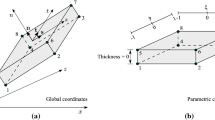Abstract
The analysis of defects in engineering structures and components has to take into account the singular strain field at the crack tip. The problems encountered in such analyses have unique geometries, have some non-linear elastic plastic behaviour and are three-dimensional in nature. Their solution calls for the use of the finite element method. Two-dimensional fracture mechanics analysis methods have been developed and proved by other researchers to show that 8-noded collapsed finite elements have the required singular strain fields for both the elastic and perfectly plastic material conditions. This paper proves the conditions under which three-dimensional collapsed elements represent the stress/strain fields at a crack tip required for elastic and perfectly plastic material, including crack tip blunting in the latter case. The collapsed elements presented can be used with confidence and give large savings in computing time, which is an essential point in three-dimensional finite element calculations.
Résumé
L'analyse des défauts dans les constructions et dans les composants doit prendre en considération le champ singulier de déformation à l'extrémité d'une fissure. Les problèmes rencontrés dans une telle analyse présentent des géométries uniques, un comportement élasto-plastique sensiblement non linéaire et sont tri-dimensionnelles par nature. Leur solution fait appel à l'utilisation de la méthode par éléments finis. Des méthodes d'analyse en mécanique de rupture bi-dimensionnelles ont été développées, et d'autres chercheurs ont établi qu'elles montrent que les éléments finis à 8 noeuds présentent les champs de déformation singuliers, requis à la fois pour les conditions de matériaux élastiques et parfaitement plastiques. La présente étude établit les conditions sous lesquelles des éléments tri-dimensionnels représentent les champs contrainte/déformation à l'extrémité d'une fissure, requis dans le cas de matériaux élastiques et parfaitement plastiques, y compris l'arrondissement de l'extrémité de la fissure pour ce dernier cas. Les éléments présentés peuvent être utilisés avec confiance et procurent de grandes économies de temps dans les calculs, ce qui est essentiel dans le cas des éléments finis à 3 dimensions.
Similar content being viewed by others
Abbreviations
- x, y, z :
-
coordinates in the real space
- g, h, s :
-
coordinates in the normalized cubic space
- λ, μ, ξ:
-
coordinates in modified normalized cubic space
- u, v, w :
-
vectors of displacements inx, y andz direction, respectively
- α :
-
vectors of coordinatesx, y andz
- β :
-
vectors of displacementsu, v andw
- N :
-
vector of shape functions
- M :
-
vector of reduced shape functions
- σ :
-
vector of stress components
- ε:
-
vector of strain components
- D :
-
matrix containing material properties
- ‖J‖:
-
determinant of the Jacobian matrix
- J :
-
Jacobian matrix
- r :
-
distance from the crack tip
References
R.S. Barsoum,International Journal for Numerical Methods in Engineering 10 (1976) 25–37.
R.S. Barsoum,International Journal for Numerical Methods in Engineering 11 (1977) 85–98.
R.D. Henshell and K.G. Shaw,International Journal for Numerical Methods in Engineering 9 (1975) 495–507.
L. Banks-Sills and Y. Bortman,International Journal of Fracture 25 (1984) 169–180.
H.M. Westergaard,Journal of Applied Mechanics 61 (1939) A49–53.
P.C. Paris and G.C. Sih, inASTM STP 391 (1965) 30–81.
H. Tada, P.C. Paris and G.R. Irwin,The Stress Analysis of Cracks Handbook, Del Research Corporation, Hellertown, Pennsylvania (1973).
M.A. Hussain, L.F. Coffin and K.A. Zaleski,Computers & Structures 13 (1981) 595–599.
C. Manu,Computers & Structures 17 (1983) 227–231.
J. Prij, Investigation on Crack Growth Parameters in the Elastic Plastic Region, Report ECN-114, Netherlands Energy Foundation, ECN (1982).
J.R. Rice and G.F. Rosengren,Journal of the Mechanics and Physics of Solids 16 (1968) 1–12.
J.W. Hutchinson,Journal of the Mechanics and Physics of Solids 16 (1968) 13–31.
J.W. Hutchinson,Journal of the Mechanics and Physics of Solids 16 (1968) 337–347.
L.P. Harrop, inProceedings of the First International Conference on Numerical Methods in Fracture Mechanics, Swansea (1978).
C.E. Freese and D.M. Tracey,International Journal of Fracture 12 (1976) RCR 767–770.
O.C. Zienkiewicz,The Finite Element Method, McGraw-Hill (1977).
Author information
Authors and Affiliations
Rights and permissions
About this article
Cite this article
Koers, R.W.J. Use of modified standard 20-node isoparametric brick elements for representing stress/strain fields at a crack tip for elastic and perfectly plastic material. Int J Fract 40, 79–110 (1989). https://doi.org/10.1007/BF00963969
Received:
Accepted:
Issue Date:
DOI: https://doi.org/10.1007/BF00963969




